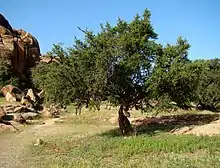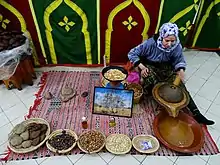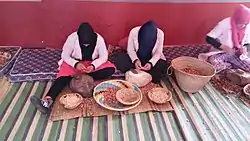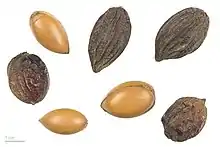Argania
Argania (Berber: ⴰⵔⴳⴰⵏ argan) is a genus of flowering plants containing the sole species Argania spinosa, known as argan, a tree endemic to the calcareous semidesert Sous valley of southwestern Morocco[3] and to the region of Tindouf in southwestern Algeria.[4][5] Argan trees grow to 8–10 m (26–33 ft) high and live up to approximately 200 years. They are thorny, with gnarled trunks and wide spreading crown. The crown has a circumference of about 70 m (230 ft) and the branches lean towards the ground.
| Argania | |
|---|---|
 | |
| Scientific classification | |
| Kingdom: | Plantae |
| Clade: | Tracheophytes |
| Clade: | Angiosperms |
| Clade: | Eudicots |
| Clade: | Asterids |
| Order: | Ericales |
| Family: | Sapotaceae |
| Subfamily: | Sapotoideae |
| Tribe: | Sideroxyleae |
| Genus: | Argania Roem. & Schult.[1] |
| Species: | A. spinosa |
| Binomial name | |
| Argania spinosa (L.) Skeels | |
| Synonyms[2] | |
| |
| Argan, practices and know-how concerning the argan tree | |
|---|---|
 Argan paste making | |
| Country | Morocco |
| Reference | 955 |
| Inscription history | |
| Inscription | 2014 (14nd session) |
| List | Representative |
 | |
The leaves are small, 2–4 cm (0.79–1.57 in) long, and oval with a rounded apex. The flowers are small, with five pale yellow-green petals; flowering in April. The fruit is 2–4 cm (0.79–1.57 in) long and 1.5–3 cm (0.59–1.18 in) broad, with a thick, bitter peel surrounding a sweet-smelling but unpleasantly flavored layer of pulpy pericarp. This surrounds the very hard nut, which contains one (occasionally two or three) small, oil-rich seeds. The fruit takes over a year to mature, ripening in June to July of the following year.
Name
The scientific name Argania is derived from argan, the name of the tree in Shilha, the Berber language which is spoken by the majority of the people living in the areas where the tree is endemic. Shilha Berber has a rich vocabulary for the various parts of the fruit, its stages of ripeness, and its harvesting and processing. The oil is also called argan. In medieval Arabic pharmacological sources, the tree is known as harjān, a distortion of the Berber word argan.
Cultivation
_tree_in_Morocco.jpg.webp)
In Morocco, arganeraie forests now cover some 8,280 km2 (3,200 sq mi) and are designated as a UNESCO biosphere reserve. Their area has shrunk by about half during the last 100 years, due to charcoal making, grazing, and increasingly intensive cultivation. The best hope for the conservation of the trees may lie in the recent development of a thriving export market for argan oil as a high-value product. However, the wealth brought by argan oil export has also created threats to argan trees in the form of increased goat population. Locals use the newfound wealth to buy more goats and the goats stunt the growth of the argan trees by climbing up and eating their leaves and fruit.[6] It is reported that the display of the tree climbing goats is staged or faked and may be considered animal abuse.[7][8]

Argan is also grown in the Arabah and Negev regions of Israel.[9][10][11]
Uses
In some parts of Morocco, argan takes the place of the olive as a source of forage, oil, timber, and fuel in Berber society.
Especially near Essaouira, the argan tree is frequently climbed by goats.[12]
Fruit
Argan fruit falls in July, when they are black and dry. Until this happens, goats are kept out of the argan woodlands by wardens. Rights to collect the fruit are controlled by law and village traditions. The leftover nuts are gathered after consumption and spit out by ruminating goats. Seeds spat out by the goats constitute an overlooked mechanism of seed dispersal.[13]
Argan oil
Argan oil is produced by several women's co-operatives in the southwestern parts of Morocco. The most labor-intensive part of oil-extraction is removal of the soft pulp (used to feed animals) and the cracking by hand, between two stones, of the hard nut. The seeds are then removed and gently roasted. This roasting accounts for part of the oil's distinctive, nutty flavor.[14]
The traditional technique for oil extraction is to grind the roasted seeds to paste, with a little water, in a stone rotary quern. The paste is then squeezed by hand to extract the oil. The extracted paste is still oil-rich and is used as animal feed. Oil produced this way can be stored and used for 3–6 months, and will be produced as needed in a family, from a store of the kernels, which will keep for 20 years unopened. Dry-pressing is becoming increasingly important for oil produced for sale, as this method allows for faster extraction, and the oil produced can be used for 12–18 months after extraction.
The oil contains 80% unsaturated fatty acids, is rich in essential fatty acids, and is more resistant to oxidation than olive oil. Argan oil is used for dipping bread, on couscous, salads, and similar uses. A dip for bread known as amlou is made from argan oil, almonds, and peanuts, sometimes sweetened by honey or sugar. The unroasted oil is traditionally used as a treatment for skin diseases, and has become favoured by European cosmetics manufacturers.[15][16][17]


Argan oil is sold in Morocco as a luxury item. Sales of the product have grown since being marketed by the cosmetics industry in the US and Europe in the early 21st century. Its price is notable compared to other oils.[18]
Argan oil contains:[19]
- 46% Oleic acid
- 32% Linoleic acid
- 12% Palmitic acid
- 6% Stearic acid
Animal feed
Argan trees are a major source of forage for sheep, goats, camels and cattle. Fruits and leaves are readily consumed by livestock. The press cake resulting from oil extraction can also be sun dried and fed to ruminants. Bees can nest in argan trees, making them sites for wild honey harvesting.[20]
References
- "Genus: Argania Roem. & Schult". Germplasm Resources Information Network. United States Department of Agriculture. 2009-03-31. Retrieved 2010-12-10.
- "Argania spinosa". Germplasm Resources Information Network (GRIN). Agricultural Research Service (ARS), United States Department of Agriculture (USDA). Retrieved 2010-12-10.
- http://www.worldagroforestry.org/treedb/AFTPDFS/Argania_spinosa.PDF, p.2
- Kouidri, M.; Saadi, A. K.; Noui, A. (2014). "Physicochemical Study and Composition of Argania spinosa Oil from Two Regions of Algeria". Chemistry of Natural Compounds. 50 (2): 346–348. doi:10.1007/s10600-014-0949-1. S2CID 36309638.
- "Characterization of the argan tree of southwestern Algeria" (PDF).
- Tim Wall (September 22, 2011). "Tree-Going Goats Threaten Oil Supply_Discovery News". Discovery News.
- "Iconic 'tree-climbing' goats of Morocco revealed to be a scam".
- Frary, Mark (2019-05-03). "Iconic and Instagrammable or invented and inhumane? Morocco's tree goats". WTM Insights. Retrieved 2019-06-03.
- Growing for Change, Ruhama Shattan, Jerusalem Post, Oct. 12, 2001
- Growth and oil production of argan in the Negev Desert of Israel, A. Nerd, E. Etesholaa, N. Borowyc and Y. Mizrahi, Industrial Crops and Products, Volume 2, Issue 2, February 1994, Pages 89-95
- Phenology, breeding system and Fruit development of Argan [Argania spinosa, Sapotaceae] cultivated in Israel, Avinoam Nerd1, Vered Irijimovich2 and Yosef Mizrahi, Economic Botany, Volume 52, Number 2 / April, 1998, pl 161-167.
- Infos at the-tree.org.uk Archived September 24, 2006, at the Wayback Machine
- Delibes, Miguel; el al (2 May 2017). "Tree-climbing goats disperse seeds during rumination" (PDF). Frontiers in Ecology and the Environment. 15 (4): 222–223. doi:10.1002/fee.1488. hdl:10261/158050.
- Charrouf, Zoubida; Guillaume, Dominique (1999). "Ethnoeconomical, ethnomedical, and phytochemical study of Argania spinosa (L.) Skeels". Journal of Ethnopharmacology. 67 (1): 7–14. doi:10.1016/S0378-8741(98)00228-1. PMID 10616955.
- Khallouki, F; Younos, C; Soulimani, R; Oster, T; Charrouf, Z; Spiegelhalder, B; Bartsch, H; Owen, RW (2003). "Consumption of argan oil (Morocco) with its unique profile of fatty acids, tocopherols, squalene, sterols and phenolic compounds should confer valuable cancer chemopreventive effects". European Journal of Cancer Prevention. 12 (1): 67–75. doi:10.1097/00008469-200302000-00011. PMID 12548113. S2CID 12350686.
- "Arganolie informative (NL)". Archived from the original on September 7, 2013. Retrieved November 5, 2016.
- Charrouf, Zoubida; Guillaume, Dominique (2008). "Argan oil: Occurrence, composition and impact on human health". European Journal of Lipid Science and Technology. 110 (7): 632. doi:10.1002/ejlt.200700220.
- Chimi, H; Cillard, J; Cillard, P (1994). "Autoxydation de l'huile d'argan Argania spinosa L. du Maroc" [Autoxidation of argan oil Argania spinoza L. from Morocco]. Sciences des Aliments (in French). 14 (1): 117–24. ISSN 0240-8813.
- Charrouf, Zoubida; Guillaume, Dominique (2010). "Should the Amazigh Diet (Regular and Moderate Argan-Oil Consumption) have a Beneficial Impact on Human Health?". Critical Reviews in Food Science and Nutrition. 50 (5): 473–7. doi:10.1080/10408390802544520. PMID 20373191. S2CID 41530834.
- Heuzé V., Tran G., 2015. Argan (Argania spinosa). Feedipedia, a programme by INRA, CIRAD, AFZ and FAO. Last updated on October 26, 2015, 16:29
- T.J. Lybbert (2007). "Patent Disclosure Requirements and Benefit Sharing: A counterfactual case of Morocco's argan oil". Ecological Economics. 64 (1): 12–18. doi:10.1016/j.ecolecon.2007.06.017.
- T.J. Lybbert; C.B. Barrett (2004). "Does Resource Commercialization Induce Local Conservation? A Cautionary Tale from Southwestern Morocco" (PDF). Society & Natural Resources. 17 (5): 413–430. doi:10.1080/08941920490430205. hdl:1813/57696. S2CID 18631871.
- T.J. Lybbert; C.B. Barrett; H. Najisse (2002). "Market-Based Conservation and Local Benefits: The Case of Argan Oil in Morocco". Ecological Economics. 41 (1): 125–144. doi:10.1016/S0921-8009(02)00020-4.
- O. M'Hirit; M. Bensyane; F.Benchekroun; S.M. El Yousfi; M. Bendaanoun (1998). L'arganier: une espèce fruitière-forestière à usages multiples. Pierre Mardaga. ISBN 978-2-87009-684-0.
- J.F. Morton; G.L. Voss (1987). "The argan tree (Argania sideroxylon, Sapotataceae), a desert source of edible oil". Economic Botany. 41 (2): 221–233. doi:10.1007/BF02858970. S2CID 23198131.
- Rachida Nouaim (2005). L'arganier au Maroc: entre mythes et réalités. Une civilisation née d'un arbreune espèce fruitière-forestière à usages multiples. Paris: L'Harmattan. ISBN 978-2-7475-8453-1.
- H.D.V. Prendergast; C.C. Walker (1992). "The argan: multipurpose tree of Morocco". Kew Magazine. 9 (2): 76–85. doi:10.1111/j.1467-8748.1992.tb00072.x.
- Elaine M. Solowey (2006). Supping at God's table. Thistle Syndicate. pp. 75–76. ISBN 978-0-9785565-1-8.
- Cristiano, Luigi; De Martino, Gianni (2000). "Marocco atlantico. In terra di Argania". Erboristeria Domani. 233: 78–85.
External links
| Wikimedia Commons has media related to Argania spinosa. |
| Wikispecies has information related to Argania spinosa. |
- "Argan Foundation". Archived from the original on 3 January 2006. Retrieved January 15, 2006.
- "Arganeraie". Archived from the original on September 21, 2005. Retrieved January 15, 2006.
- "Trade and Environment Database: argan oil". Archived from the original on 6 February 2006. Retrieved January 22, 2006.
- "Biodiversity of South Western Morocco (Flora and Plant Communities of Morocco)". Retrieved October 29, 2006.
- R. Nouaim; G. Mangin; M. C. Breuil; R. Chaussod (2002). "The argan tree in Marocco: Propagation by seeds, cuttings and in-vitro techniques". Agroforestry Systems. 54 (1): 71–81. doi:10.1023/A:1014236025396. S2CID 21621498.
- Kitty Morse, Ardent for Argan, 2004, Saudi Aramco World
